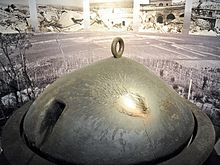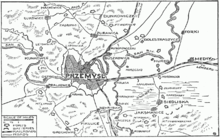Siege of Przemyśl
| date | September 16, 1914 to March 22, 1915 |
|---|---|
| place | Przemyśl , Poland |
| output | russian victory |
| Parties to the conflict | |
|---|---|
| Commander | |
| Troop strength | |
| about 130,000 men | about 300,000 men |
| losses | |
|
approx. 20,000 dead and 110,000 prisoners |
approx. 110,000 dead and wounded, 40,000 of them in the first three days |
Eastern Front (1914-1918)
1914
East Prussian operation ( Stallupönen , Gumbinnen , Tannenberg , Masurian Lakes ) - Galicia ( Kraśnik , Komarów , Gnila Lipa , Lemberg ,
Rawa Ruska ) - Przemyśl - Vistula - Krakow - Łódź - Limanowa - Lapanow - Carpathians
1915
Humin - Mazury - Zwinin - Przasnysz - Gorlice-Tarnów - Bug Offensive - Narew Offensive - Great Retreat - Novogeorgiewsk - Rovno - Swenziany Offensive
1916
Lake Narach - Brusilov offensive - Baranovichi offensive
1917
Aa - Kerensky offensive ( Zborów ) - Tarnopol offensive - Riga - Albion company
1918
Operation Punch

The siege of Przemyśl was the greatest siege of the First World War and a heavy defeat for Austria-Hungary . The first enclosure by the Russian army took place from September 16, 1914 to October 11. On November 9th a second siege attempt began, which lasted 133 days. The Austro-Hungarian garrison , which still consisted of 110,000 soldiers, capitulated on March 22, 1915 and was taken prisoner by Russia .
background
Because of the important traffic location of Przemyśl , one of the largest fortress complexes existing before the First World War was built around the town from the middle of the 19th century. It consisted of a forty-five kilometer belt of fortifications with several dozen forts , which in turn were connected by walls.
In the Battle of Galicia , troops on the Russian Southwest Front under the command of General Nikolai Ivanov defeated the Austrians, after the Battle of Lviv the capital of Galicia was lost, and by mid-September the whole front moved 100 kilometers further west into the Carpathian Mountains .
After the Russian breakthrough at Rawa Ruska on September 11th, the last attempts of the Austrian Chief of Staff Conrad von Hötzendorf to recapture the capital Lemberg had finally failed. In mid-September 1914, the defeated Austrian army had to surrender the Sanlinie before the strong pressure of the Russian south-western front and retreat to the Wisloka . The Przemyśl fortress was surrounded by the Russian 3rd Army under Radko Dimitriew from September 16 and gave the Austro-Hungarian troops the time they needed to break away. The Russian armies standing further north were already threatening German Silesia . Therefore, the defense of the fortress was of great importance not only for the Austrians, but also for the Germans.
The first siege
After the retreat of the Austrians to the San, the fortress was enclosed by the Russians on September 16. On September 20, Russian units crossed the river at Walava , 8 km north of the fortress, and began to march on the other bank.
On September 21, the Imperial and Royal 3rd Army under General Boroevic gave up the last eastern bridgehead at Jaroslau . The Przemyśl fortress then remained completely behind the Russian lines and was the last Austrian base that withstood the Russian advance. The fortress commander Hermann Kusmanek von Burgneustädten had the 23rd Honved Division and the 93rd, 97th, 108th and 111th Landsturm Brigade in the fortress. Together with four Honved marching regiments and the pioneer group under Major General Nickel, there were 65 infantry battalions in the fortress, mostly consisting of Ruthenians and Hungarians . The fortress artillery was largely out of date; of the 38 belt works of the outer defensive ring, only twelve had been modernized and provided with reinforced ceilings. Of the 988 existing fortress guns, only 28 were state-of-the-art at the time.
On September 22nd and 23rd the Russians pushed their troops against the north and south fronts of the fortress. On September 24th, the commander-in-chief of the Russian 3rd Army , General Radko Dimitriev , began the attack on the fortress. The Russians did not have enough siege artillery available on site, but an Austrian reinforcement had to be expected. Therefore it was decided on the Russian side to attack. For three days the Russians stormed the fortress without success and lost 40,000 men in the dead and wounded. Despite the attacks, supplies from outside were possible until September 26th, after which the Russians had completely closed the fortress. On the northern section was the XXIX. Army Corps with the 78th and 82nd Reserve and 12th Infantry Divisions, on the south bank of the San the XXVIII. Army Corps with the 58th, 60th and 69th Reserve Divisions. This blockade group was by the 19th Infantry Division of the XII. Army Corps and the 9th Cavalry Division reinforced.
Meanwhile, the newly formed German 9th Army under General Paul von Hindenburg launched an offensive in Russian Poland on the Silesian border . At the beginning of October the attacking 3rd Army under General Boroević was able to bring reinforcements to Przemyśl, so that Dimitriev lifted the siege on October 11th and withdrew behind the San with his Russian troops . Conrad hoped that a joint attack by the 3rd and 4th Armies and an outbreak of the Przemysl garrison would deal a hard blow to the Russians in the Battle of the San .
The second siege
By October 31, Hindenburg was defeated in the Battle of the Vistula and withdrew with his armies. This also forced the Austro-Hungarian 3rd Army under Boroević to evade west and to break off the attacks on the San. On November 9, 1914, the advancing Russians were able to continue the siege of Przemyśl, but not with the units of Dimitriev, who moved north , but with the newly founded 11th Army under General Andrei Seliwanow . Selivanov did not order frontal attacks like Dimitriev had before, but relied on starving the garrison by blocking and forcing it to surrender.
In February 1915, the 3rd Army under General von Boroević failed several times in the battle in the Carpathians with the kuk VII and X Corps when attempting to relieve the Przemyśl fortress due to strong Russian resistance. At the end of February, the Austro-Hungarian 2nd Army under General von Böhm-Ermolli was relocated from Russian Poland to Galicia for reinforcement . Between February 27 and March 14, 1915, the Tersztyánszky corps group wrestled with the newly appointed kuk IV., XVIII. and XIX. Corps in vain to break through to the fortress via Baligrod. All relief attacks were successfully repulsed by the Russian 8th Army under General Brusilov , the Austro-Hungarian attack units suffered heavy losses. Conrad informed the fortress commander Kusmanek that the relief attempt had failed and that reinforcements could no longer be brought to Przemyśl.
General Selivanov now had enough artillery to shoot down the fortress. On March 13, the Russians overran the northern defensive lines. An improvised line of defense held up the Russians long enough for Kusmanek to carry out the destruction of anything that could have been of military use to the Russians after the capture. On March 19, he ordered an attempt to escape. But the attacks of the 23rd Honved Infantry Division under Lieutenant Field Marshal Árpád Tamásy von Fogaras were repulsed and the troops pushed back into the fortress. Since the food in Przemyśl was almost completely used up, Kusmanek was finally forced to surrender. On March 22nd, Kusmanek and the remaining garrison surrendered to the Russians. A total of 9 generals, 2,300 officers and 110,000 soldiers were captured by Russia.
consequences
The loss of Przemyśl heightened fears in Austria of a major Russian offensive on the Hungarian lowlands . This did not materialize, but the fall of the Przemyśl Fortress was a severe blow to Austrian morale. Only the breakthrough of the Central Powers after the Battle of Gorlice-Tarnów in early May 1915 changed the situation. When the front shifted to the east again, on June 3 and 4, 1915, the kuk X. Corps ( Martiny ) in cooperation with the 11th Bavarian Division ( Kneussl ) succeeded in recapturing the Przemyśl fortress.
Museum reception

In the Military History Museum in Vienna an 8 cm tank turret dome is from the fortress Przemyśl issued ( factory I / 2). The dome shows a direct hit from a Russian 25 cm mortar shell. However, the projectile turned out to be too weak to penetrate the tank. After the fortress was recaptured in June 1915, the dome was removed and transported to Vienna. At the war exhibition in the Prater and in the Army Museum, it was meant to remind of the battles for the fortress.
Literature and Sources
- Albert Pethö (Ed.): Siege and Captivity. From Przemyśl to Russian Turkestan. The war memories of Dr. Richard Ritter von Stenitzer 1914–1917. Ares Verlag , Graz 2010, ISBN 978-3-902475-83-1 .
- Spencer Tucker: The Great War: 1914-1918 . Routledge, London 1998.
Individual evidence
- ↑ a b Matthias Kneip, World War I fortress in Eastern Poland: Dreams of the thunder of cannons , one day
- ^ Manfried Rauchsteiner , Manfred Litscher: The Heeresgeschichtliche Museum in Vienna . Verlag Styria, Graz / Vienna 2000, ISBN 3-222-12834-0 , p. 68.
- ^ Army History Museum / Military History Institute (ed.): The Army History Museum in the Vienna Arsenal . Verlag Militaria , Vienna 2016, ISBN 978-3-902551-69-6 , p. 112.






